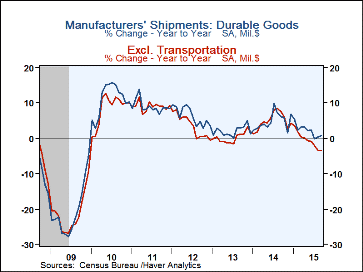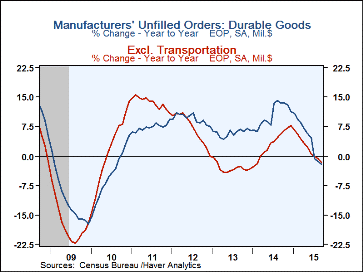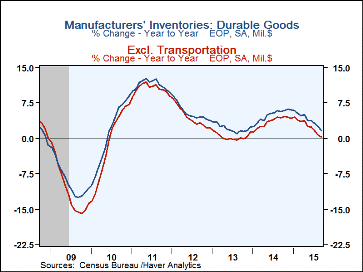 Global| Oct 27 2015
Global| Oct 27 2015U.S. Durable Goods Orders Decline Is Broad-Based
by:Tom Moeller
|in:Economy in Brief
Summary
New orders for durable goods fell 1.2% during September (-3.0% y/y) following a 3.0% August drop, revised from -2.0%. Expectations had been for a 1.0% decline in the Action Economics Forecast Survey. During the last ten years, there [...]
New orders for durable goods fell 1.2% during September (-3.0% y/y) following a 3.0% August drop, revised from -2.0%. Expectations had been for a 1.0% decline in the Action Economics Forecast Survey. During the last ten years, there has been an 88% correlation between the y/y change in durable goods orders and the change in real GDP. Weakness in durable goods bookings was pervasive during both Q3 and Q2.
Last month's decline was paced by a 7.6% drop (-13.2% y/y) in orders for nondefense capital goods. A 35.7% drop (-37.2% y/y) in aircraft & parts led the decline. Nondefense capital goods orders excluding aircraft & parts eased 0.3% (-7.3% y/y) after a 1.6% shortfall. Elsewhere in the transportation sector, motor vehicle & parts orders increased 1.8% (13.1% y/y). Overall orders excluding the transportation sector eased 0.4% (-5.3% y/y). They improved 0.2% during all of last quarter after a 0.6% dip in Q2.
In most other durable goods sectors, orders were soft. Primary metals orders fell 2.9% (-18.7% y/y), the fourth decline in as many months. Fabricated metals orders did rise 1.7% (-3.9% y/y), but the gain followed two months of sharp decline. Machinery orders fell 1.3% (-8.8% y/y) after a 1.0% drop. Computer & electronic product bookings declined 0.6% (+4.8% y/y) after being roughly unchanged in August. Computer & related product orders fell 4.5% (-9.0% y/y), down hard for the third straight month. Communications equipment orders bucked these negative readings with a 2.4% gain (9.4% y/y). Electrical equipment orders also improved, but by just 0.3% (-8.5% y/y).
Shipments of durable goods gained 0.2% (0.7% y/y) following a 0.5% decline. Shipments excluding transportation eased 0.1% (-3.5% y/y), off for the third straight month. Unfilled durable goods orders fell 0.6% (-2.2% y/y) while backlogs excluding transportation declined 0.3% (-1.6% y/y), off for the eighth straight month. Decumulation of inventories continued for the fourth month in the last five. A 0.3% decline left them up, however, 1.7% y/y. Inventories excluding transportation gained 0.1% (0.3% y/y) following two months of decline.
The durable goods figures are available in Haver's USECON database. The Action Economics consensus forecast figure is in the AS1REPNA database.
| Durable Goods NAICS Classification | Sep | Aug | Jul | Sep Y/Y | 2014 | 2013 | 2012 |
|---|---|---|---|---|---|---|---|
| New Orders (SA, %) | -1.2 | -3.0 | 1.9 | -3.0 | 6.8 | 2.2 | 6.3 |
| Transportation | -2.9 | -6.9 | 4.9 | 2.1 | 6.1 | 6.5 | 16.6 |
| Total Excluding Transportation | -0.4 | -0.9 | 0.4 | -5.3 | 7.2 | 0.1 | 2.0 |
| Nondefense Capital Goods | -7.6 | -4.7 | 0.6 | -13.2 | 6.6 | 2.8 | 10.8 |
| Excluding Aircraft | -0.3 | -1.6 | 1.9 | -7.3 | 6.3 | -1.0 | 7.6 |
| Shipments | 0.2 | -0.5 | 1.0 | 0.7 | 4.8 | 2.0 | 6.3 |
| Inventories | -0.3 | -0.2 | -0.2 | 1.7 | 6.1 | 2.4 | 3.8 |
| Unfilled Orders | -0.6 | -0.3 | 0.2 | -2.2 | 11.4 | 6.4 | 7.5 |
Tom Moeller
AuthorMore in Author Profile »Prior to joining Haver Analytics in 2000, Mr. Moeller worked as the Economist at Chancellor Capital Management from 1985 to 1999. There, he developed comprehensive economic forecasts and interpreted economic data for equity and fixed income portfolio managers. Also at Chancellor, Mr. Moeller worked as an equity analyst and was responsible for researching and rating companies in the economically sensitive automobile and housing industries for investment in Chancellor’s equity portfolio. Prior to joining Chancellor, Mr. Moeller was an Economist at Citibank from 1979 to 1984. He also analyzed pricing behavior in the metals industry for the Council on Wage and Price Stability in Washington, D.C. In 1999, Mr. Moeller received the award for most accurate forecast from the Forecasters' Club of New York. From 1990 to 1992 he was President of the New York Association for Business Economists. Mr. Moeller earned an M.B.A. in Finance from Fordham University, where he graduated in 1987. He holds a Bachelor of Arts in Economics from George Washington University.










